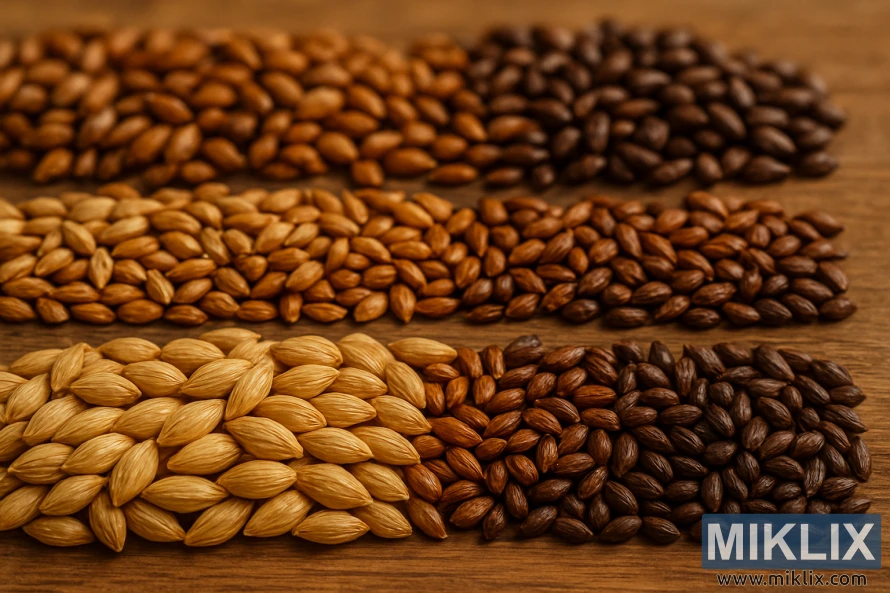Image: Close-up of pale and specialty malts
Published: July 19, 2025 at 10:02:46 PM UTC
Last updated: September 27, 2025 at 3:24:31 PM UTC
A close-up of pale and specialty malts like caramel, Munich, and chocolate, arranged on wood with warm lighting to highlight their colors and textures for brewing.
Spread across a rustic wooden surface, the neatly arranged rows of malted barley grains form a gradient of color and texture that speaks to the complexity and artistry of brewing. This close-up composition is more than a visual study—it’s a tactile narrative of transformation, where each grain represents a distinct stage in the malting and roasting process. The lighting is soft and warm, casting gentle shadows that accentuate the contours of the grains and the subtle sheen of their husks. The interplay of light and shadow brings out the richness of the colors, from the pale golds of base malts to the deep, chocolate browns of heavily roasted specialty varieties.
In the foreground, the pale malt commands attention with its plump, uniform kernels. These grains are lightly kilned, retaining a soft golden hue and a smooth, slightly translucent surface. Their size and shape suggest high enzymatic potential, making them ideal for conversion during mashing. This malt forms the backbone of most beer recipes, contributing fermentable sugars and a clean, biscuity flavor that serves as a canvas for more expressive ingredients. Surrounding the pale malt are increasingly darker grains, each with its own story and purpose. The caramel malts, with their amber tones and slightly sticky texture, hint at sweetness and body, offering flavors of toffee, honey, and dried fruit. Munich malts, slightly darker and more robust, bring depth and a rich, bready character that enhances malt-forward styles like bocks and amber ales.
Further along the spectrum, the chocolate and roasted malts deepen the visual and sensory experience. Their dark brown to nearly black hues suggest intense roasting, and their brittle texture reveals the transformation of starches into complex melanoidins. These malts contribute notes of coffee, cocoa, and char, essential for stouts, porters, and other dark beer styles. The careful arrangement of the grains in horizontal rows not only creates a visually satisfying gradient but also serves as an educational tool, illustrating the progression of color and flavor that results from varying degrees of kilning and roasting.
The wooden surface beneath the grains adds warmth and authenticity to the scene, its natural grain and imperfections echoing the agricultural origins of the malt. It grounds the composition in tradition, reminding the viewer that brewing, despite its scientific precision, is rooted in the rhythms of nature and the hands of the farmer and maltster. The overall atmosphere is one of quiet reverence—a celebration of the raw materials that, through careful handling and creative vision, become the soul of beer.
This image invites contemplation not just of the ingredients themselves, but of the choices a brewer must make. Each grain offers a different path, a different flavor profile, a different story. The composition captures the essence of brewing as both craft and science, where understanding the nuances of malt is key to shaping the final product. It’s a portrait of potential, a palette of possibility, and a tribute to the humble grain that lies at the heart of every great brew.
The image is related to: Brewing Beer with Pale Malt

